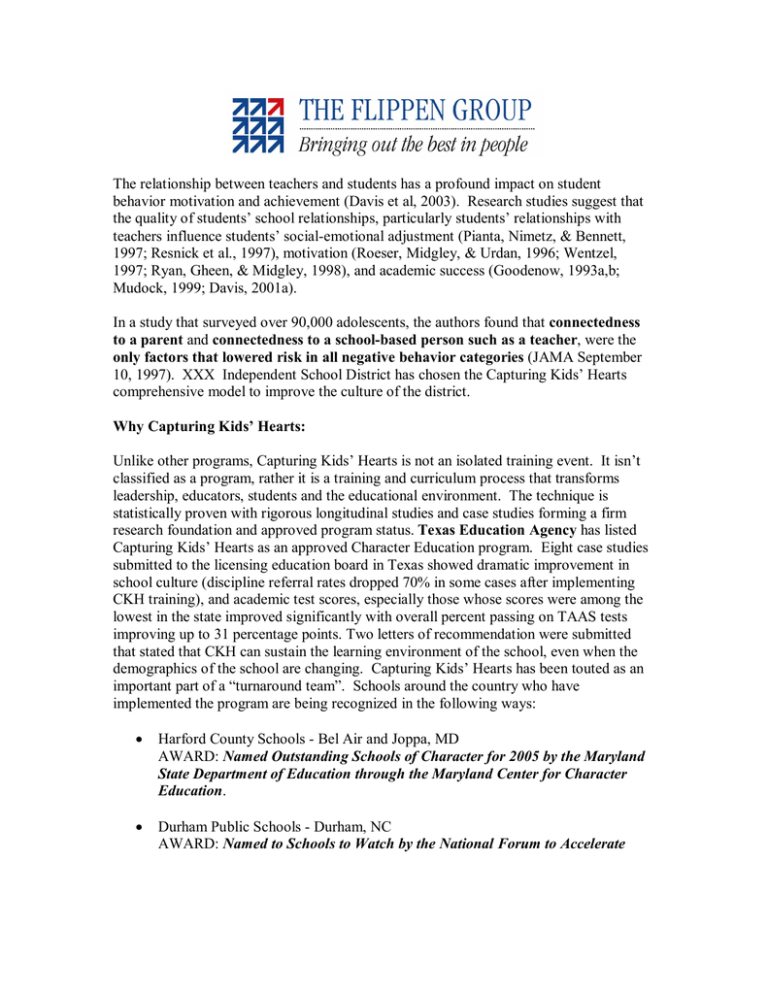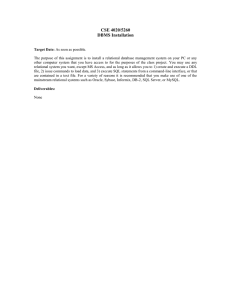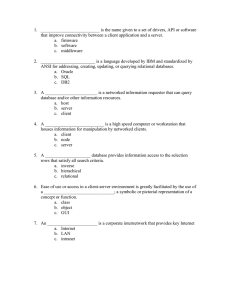The relationship between teachers and students
advertisement

The relationship between teachers and students has a profound impact on student behavior motivation and achievement (Davis et al, 2003). Research studies suggest that the quality of students’ school relationships, particularly students’ relationships with teachers influence students’ social­emotional adjustment (Pianta, Nimetz, & Bennett, 1997; Resnick et al., 1997), motivation (Roeser, Midgley, & Urdan, 1996; Wentzel, 1997; Ryan, Gheen, & Midgley, 1998), and academic success (Goodenow, 1993a,b; Mudock, 1999; Davis, 2001a). In a study that surveyed over 90,000 adolescents, the authors found that connectedness to a parent and connectedness to a school­based person such as a teacher, were the only factors that lowered risk in all negative behavior categories (JAMA September 10, 1997). XXX Independent School District has chosen the Capturing Kids’ Hearts comprehensive model to improve the culture of the district. Why Capturing Kids’ Hearts: Unlike other programs, Capturing Kids’ Hearts is not an isolated training event. It isn’t classified as a program, rather it is a training and curriculum process that transforms leadership, educators, students and the educational environment. The technique is statistically proven with rigorous longitudinal studies and case studies forming a firm research foundation and approved program status. Texas Education Agency has listed Capturing Kids’ Hearts as an approved Character Education program. Eight case studies submitted to the licensing education board in Texas showed dramatic improvement in school culture (discipline referral rates dropped 70% in some cases after implementing CKH training), and academic test scores, especially those whose scores were among the lowest in the state improved significantly with overall percent passing on TAAS tests improving up to 31 percentage points. Two letters of recommendation were submitted that stated that CKH can sustain the learning environment of the school, even when the demographics of the school are changing. Capturing Kids’ Hearts has been touted as an important part of a “turnaround team”. Schools around the country who have implemented the program are being recognized in the following ways: · Harford County Schools ­ Bel Air and Joppa, MD AWARD: Named Outstanding Schools of Character for 2005 by the Maryland State Department of Education through the Maryland Center for Character Education. · Durham Public Schools ­ Durham, NC AWARD: Named to Schools to Watch by the National Forum to Accelerate · Ridgewood Middle School ­ Arnold, MO AWARDS: Named a Promising Practice in the National Schools of Character program in 2005, and named 1 of 10 schools that received the 2006 National Schools of Character Award · Enrico Fermi High School ­ Enfield, CT Paul Newton, Principal AWARD: Named Connecticut High School Principal of the Year 2007 · White Settlement ISD ­ Fort Worth, TX Dr. Susan Simpson, Superintendent AWARD: Named Texas Superintendent of the Year 2005 · McCAULIFF Elementary ­ McAllen, TX Dr. Scott Hollinger, Principal AWARD: Named National Distinguished Principal of the Year 2003 The CKH process will be a major component of the XXX school district. CKH is based on three important leadership principles that impact key elements of safe school environments: violence prevention; risk reduction; student behavioral, social and emotional supports; and emotional learning. The key leadership track begins with relational leadership, transitioning to intentional leadership, and finally transformational leadership that makes a lasting impact on the district and the teachers, staff and students it serves. The relational component of leadership involves the concept of trust. Members of an organization must trust the intentions, integrity, and competence of other members. XXX recognizes that relationships within our district must be marked by openness, honesty, respect, affirmation, reliability, and personal regard for others. Modeling this behavior for students is critical from the top down. The CKH comprehensive program addresses all levels of leadership. Capturing Kids’ Hearts is designed to improve the culture of the district by increasing the “relational capacity” of administrators, teachers and students. “Relational capacity” is the ability within the relationships in a school to withstand and absorb struggles and issues that must be addressed. Through acquisition of relational skills and discipline management strategies, administrators and teachers will increase the level of cooperation between staff members and will improve the feeling of connectedness that students feel toward teachers and peers. This is accomplished through a series of trainings (FLS 1, FLS 2, Capturing Kids’ Hearts) and mentoring programs (Process Champions and Quarterly Coaching) that will help develop high performing leaders and increase relational capacity between adults and students. Relational Leadership: Capturing Kids Hearts process teaches school staff to put time and effort into building relationships. According to Professors Anthony Bryk (Stanford University Executive Program in Educational Leadership) and Barbara Schneider (Alfred P. Sloan Center on Parents, Children, and Work at the University of Chicago), relational trust is a core resource for school improvement. They propose that a dynamic interplay among four considerations shape individuals’ analyses of the behavior of others: respect; personal regard for other; competence in core role responsibilities, and integrity. They suggest that any serious deficiency can undermine a relationship. Professor Megan Tschannen­ Moran (School of Education at The College of William and Mary in Williamsburg, VA) asserts in Trust Matters: Leadership for Successful Schools that there are five essential facets of relational trust: · Benevolence: a sense of caring; the confidence that one’s well­being or something one cares about will be protected and not harmed by the trusted party; assurance that one can count on the good will of another to act in one’s best interest · Honesty: involves a person’s character, integrity, and authenticity · Openness: a process by which people make themselves vulnerable to others by sharing information, influence, and control · Reliability: the sense that one is able to depend on another consistently · Competence: the ability to perform a task as expected, according to appropriate standards There are many other references to relational trust/relational capacity, but additional ideas concerning trust fall into either Bryk’s & Schneider’s or Tschannen­Moran’s broad definitions of the facets of trust that are essential in order to develop trusting and affirming relationships. The topics of Capturing Kids’ Hearts comprehensive model that address these facets of relational trust include: · First Impressions (benevolence, respect, personal regard for others, openness) · EXCEL Model™ is key in exploring the relationships in communication (benevolence, respect, personal regard for others, competence in core responsibilities. · SOLER Listening Skills (openness, personal regard for others, benevolence, respect) · Whose Hand is This? (personal regard for others, respect, reliability, honesty) · Personal Responsibility (honesty, reliability, competence) Values (honesty, reliability, personal regard for others, benevolence) Intentional leadership Once the relational foundation has been laid, the school must be brought together through a common purpose. At the purposeful or “Intentional” level, Capturing Kids Hearts deal with discipline and school management paradigms. The components of effective school­ wide preventive discipline practices have been studied by many researchers and are summarized in Effective Schooling Practices: A Research Synthesis 1995 Update (1995) and in the School Improvement Research Series (SIRS) Close­Up #9 entitled “School­ wide and Classroom Discipline”(2002) by Kathleen Cotton (NWREL). The Capturing Kids’ Hearts process addresses all of these preventive discipline components through an emphasis on developing school­wide discipline policies, implementing “social contracts” that clearly define acceptable behavior, and developing strong relationships within the school community. Cotton also summarized the findings of numerous researchers who investigate behaviors that comprise effective discipline management at the classroom level: · Holding and communicating high expectations for student learning and behavior. · Establishing and clearly teaching classroom rules and procedures. Classroom rules are posted. · Specifying consequences and their relation to student behavior. · Enforcing classroom rules promptly, consistently, and equitably. · Sharing with students the responsibility for classroom management. · Maintaining a brisk pace for instruction and making smooth transitions between activities. · Monitoring classroom activities and providing feedback and reinforcement. Therefore, in addition to being relational, effective leaders must be intentional in purpose. Such leaders have a strong personal sense of purpose and are able to focus the attentions and energies of school members on the basic mission of the school to develop secure learning environment and enhance social skills in students that will allow them to succeed. Effective leaders promote a strong sense of purpose within the school. Transformational leadership The development of strong relationships (relational) and a commitment to a common purpose (intentional) are essential, but not sufficient, for authentic school reform to occur. Group processes must be implemented that transform a school from being a loose collection of isolated individuals doing their own work into a focused group of connected individuals who act in a concerted manner to fulfill the school’s purpose. Transformation occurs when members of the school community become convinced that the collective effects of individual actions are greater than their sum. Professor Donaldson (Department of Education at the University of Maine) calls this the “belief in action­in­common” and is the result of two group phenomena: · A conviction that organizational purposes will be met better by action­in­common than by unlinked individual effort and · Sufficient evidence from action­in­common to reinforce this conviction When members of the school community feel appreciated and connected (relational), and when they can see that the school as a whole is working toward a common purpose (intentional), then they are willing to participate beyond their job assignment and to commit personally to the collective effort to transform the school community into an effective team that moves toward its desired goals (transformational). In order to “grow the group”, Donaldson states that school leaders shape the group’s belief in their action­in­common by: · Identifying the value of interdependent work. · Ensuring a steady diet of feedback on work and its effects. · Demonstrating values that reinforce the importance of collective responsibility and collaborative work. · Enabling people to act on feedback to solve not just their own problems, but to meet organizational challenges. Healthy relationships and a strong sense of purpose are the foundation upon which school members choose to act together to meet common goals. Effective leaders encourage group processes that reward team effort. Transformation within an organization occurs when a critical mass of individuals are more inspired to accomplish that which matters most in the organization, than they are consumed with the desire to seek attention for themselves. Their cooperative and synergistic actions produce more than would be expected from the sum of their individual, but isolated efforts. Effective leaders encourage team effort. Capturing Kids Hearts will address the contextual issues of our school through the development of effective leadership. The goal is to bring about significant positive changes in students through training programs and curricula that teach relational, intentional, and transformational leadership skills and it happens at all leadership levels within the district. REFERENCES Davis, Heather A. (2003) Conceptualizing the Role and Influence of Student­Teacher Relationships on Children's Social and Cognitive Development; Educational Psychologist, 38 (4), 207 – 234 Davis, H. A. (2001). The quality and impact of relationships between elementary school students and teachers. Journal of Contemporary Educational Psychology, 26, 431­453. Goodenow, C. (1993). Classroom belonging among early adolescent students: Relationships to motivation and achievement. Journal of Early Adolescence, 13(1), 21­ 43. Goodenow, C., & Grady, K. E. (1993). The relationship of school belonging and friends’ values to academic motivation among urban adolescent students. Journal of Experimental Education, 62(1), 60­71. Murdock, T. B. (1999). The social context of risk: Status and motivational predictors of alienation in middle school. Journal of Educational Psychology, 91, 62 ­ 75. Pianta, Robert C.; Nimetz, Sheri L.; & Bennett, Elizabeth. (1997). Mother­child relationships, teacher­child relationships, and school outcomes in preschool and kindergarten. Early Childhood Research Quarterly, 12(3), 263­280. Resnick, M.D., Bearman, P.S., Blum R.W., Bauman K.E., Harris K.M., Jones, J. Tabor, J., Beuhring, T., Sieving, R.E., Shew, M., Ireland, M., Bearinger, L.H., and Udry, J.R. (1997). Protecting adolescents from harm. Findings from the National Longitudinal Study on Adolescent Health, Journal of American Medical Association, 278(10): 823­ 832. Roesner, Robert W., Midgley C., Urdan, T., (1996) Perceptions of the School Psychological Environment and Early Adolescents' Psychological and Behavioral Functioning in School: The Mediating Role of Goals and Belonging. Journal of Educational Psychology, 88, 408­422. Ryan, A., Gheen, M. H., & Midgley, C. (1998). Why do some students avoid asking for help? An examination of the interplay among students’ academic efficacy, teachers’ social­emotional role, and the classroom goal structure. Journal of Educational Psychology, 90, 528 ­ 535. Wentzel, K. R. (1998). Social relationships and motivation in middle school: The role of parents, teachers, and peers. Journal of Educational Psychology, 90(2), 202­209.


